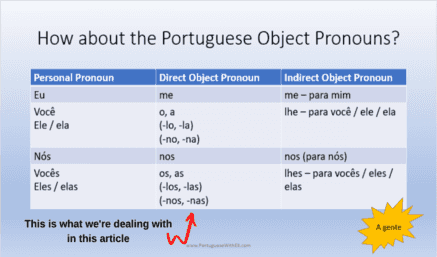Direct Object Pronouns in Portuguese — Is That Hard To Understand?

The direct object pronouns in Portuguese are much like the bogeyman — everyone has their own idea of what they are, but nobody seems to know for sure what it’s all about.
And in this article, you will know what it’s all about.
What Are the Direct Object Pronouns in Portuguese? (or pronouns, BTW?)
First off, grab your mug of coffee and sit down. Let’s talk like the experts that we are.
You already know that the pronouns are words that stand for nouns, and that nouns are words that fall into three main categories: people, places, and things.
Nouns can be subjects — and although the word might indicate otherwise, the subject is king in a sentence.
It’s the doer of an action. And the action it does is the verb (“okay kids, there are exceptions”).
The action is done upon something. It’s much like killing. There will always be a victim. And the victim, in this case, is the object of the action.
Thus, in a sentence like “I see you”, “I” is the subject, “see” is the verb, and “you” is the object.
And because “you” is replacing your name — which I know what it is, by the way —, it’s a pronoun. Hence, it’s an object pronoun.
Let’s Breath… Now, Moving On
As I said, verbs are like murderers. Sometimes they kill empty-handed, sometimes they need weapons to do their thing.
In this grammatical thriller, the weapons are prepositions — at least in Portuguese.
A direct killing, i.e. empty-handed, is done without a preposition.
In the sentence “I see you” there is no preposition. So, the action is done directly upon “you”. “You”, then, is the direct object.
If we needed a preposition — “I look at you”, for instance — it would be an indirect killing.
But, don’t worry. We’re not studying indirect object pronouns in this short lesson (but you can learn more about the indirect object pronouns here).
Now, now. Pronouns in English are more straightforward than their Portuguese counterparts. They change less often, they’re more consistent.
And because Portuguese pronouns tend to change a lot, we need to look into the matter carefully.
Direct Object Pronouns in Portuguese
I’m giving you below an incomplete table of the direct object pronouns in Portuguese.
(I will explain to you the reason for this incompleteness in a moment.)

We’ll take a look into each one of those pronouns. But let’s put up a system. Something to facilitate our understanding. As we say it, let’s “golden the pill”. (dourar a pílula, make something easier to accept.)
First Group — First Person
The first group is comprised of the pronouns for the first person.
me (me), nos (us)
- Ele me viu ontem. He saw me yesterday.
- Você pode me esperar aqui? Can you wait for me here?
- Onde você vai nos encontrar? Where will you going to meet us?
- Ela não nos viu na loja. She didn’t see us in the store.
Where should you place pronouns?
Usually, before the verb it is the object to. I’ve heard that in Portugal they do it differently but it’s Brazil were talking about it will not waste our time with these matters. (And if you happen to be from Portugal, could you help me? I’ve heard too many rumors and nothing for sure.)
Alert: you do want to pay attention to the pronunciation of “nos”. You protrude your lips like in the word “boo”. It differs greatly from “nós”.
And still on the same pronoun (we), and spoken Portuguese it tends to be used less and less. Instead, we tend to use “a gente”. I, for one, hardly ever use the regular pronoun. Only “a gente”.
The special thing about the placement of “a gente” is that it goes after the verb it’s the object to. As in the example below:
- Onde você vai encontrar a gente? Where will you go to meet us?
- Ela não viu a gente na loja. She didn’t see us in the store.
Second Group — Third Person, and a Bonus
If the first group deals with the first person, you would think the second group deals with the second person. And you’re kind of right.
I’ll tell you why in a moment. But first…
Examples!
This:
- Você viu os meninos ontem? Did you see the boys yesterday?
- Ainda não li esse livro. É bom? I haven’t read this book yet. Is it good?
- Eu sempre vejo a Paula e a Tiane na rua. I always see Paula and Tiane on the street.
- Eu compro os livros I’ll buy the books later.
Becomes this:
- Você os viu ontem? Did you see them yesterday?
- Ainda não o li. É bom? I haven’t read it yet. Is it good?
- Eu sempre as vejo na rua. I always see them on the street.
- Eu os compro depois. I’ll buy them later.
But again, we are a bunch of funny people here in Brazil. We don’t like following the rules. And our pronunciation helps us.
What I mean is, the regular third-person pronouns — the ones you just learned — are mostly used in written Portuguese. There is always that odd person who talks like they write, but they are the exception, not the rule.
You see, in spoken Portuguese, we tend to use the regular “subject pronouns” as object pronouns as well. They are easier to pronounce because they are strong. And seeing is believing (using the same examples as above):
- Você viu eles ontem? Did you see [the boys] yesterday?
- Ainda não li ele. É bom? I haven’t read [this book] yet. Is it good?
- Eu sempre vejo elas na rua. I always see [Paula and Tiane] on the street.
- Eu compro eles I’ll buy [the books] later.
And this sounds quite natural. In informal writing — WhatsApp, Facebook, emails… — this is the form people tend to use.
But if you’re preparing for CELPE-BRAS, you do want to stick to the rule and use the regular object pronouns for the third person.
Using Direct Object Pronouns with Infinitives
I said a few paragraphs ago that we usually place pronouns before the verbs they are an object to. And that’s what usually happens. But when you have the infinitive, it might change a little.
Take a look at these examples:
This:
- Eu vou comprar os livros mais tarde. I’m going to buy books later.
- Ela quer ver o Paulo ainda hoje. She wants to see Paulo today.
- Eu preciso encontrar minha professora I need to meet my teacher now.
- Eu posso mexer minhas pernas. I can move my legs.
Becomes this:
- Eu vou comprá-los mais tarde. I’m going to buy them later.
- Ela quer vê-lo ainda hoje. She wants to see him today.
- Eu preciso encontrá-la I need to meet her now.
- Eu posso mexê-las. I can move my legs.
And here you see, you just drop the R and add an accent. That accent helps us understand that the vowel should be long.
- Insert an acute accent (á) when the verb ends in A.
- Insert a circumflex accent (ê) when the verb ends in E.
Common mistake alert!
This is pretty silly and won’t do any harm, but Brazilians tend to add an accent to verbs that end in I. There is no need to. Words that end in “I” usually have the stress on the last syllable.
- Eu posso reduzir os custos. I can reduce the costs.
- Eu posso reduzí-los. (x) I can reduce them.
- Eu posso reduzi-los. 🙂
But if verbs end in -uir (possuir, destruir, construir), they need the accent.
And how about the -no and -na that we see above?
Oh, thank you for reminding me of them.
We don’t usually use them in spoken Portuguese, and a written Portuguese you only use them after verbs that and in a nasal vowel when conjugated.
This:
- Eles compraram a cerveja.
- As crianças fizeram o dever de casa.
Becomes this:
- Eles compraram-na.
- As crianças fizeram-no.
But that happens only in writing, and the placement here is optional. You could have put that before the verb and it would be okay.
A Special Case (te, você, o, a)
Do you remember that I said the table above was incomplete, and that I had a reason for that? Now it’s time to answer that point.
Because in Brazil we don’t have a “proper” second-person pronoun (like “tu” in Spanish), we use the third person conjugation with “você”.
But the common way to say, “I love you” is “eu te amo”.
How come?
That’s because the second person pronoun has never died. It has just become obsolete. In some parts of the country. So, “TE” is a holdout. It follows the same rules we talked about above and it’s pronounced “tchee” (or tea in some parts of the country).
So, to translate the sentence “I love you” you have the following options:
- Eu te amo.
- Eu amo você.
- Eu o/a amo.
But really, forget about the third option. It’s ambiguous. It could mean both I love you and I love him/her.
Takeaways
- The direct object pronouns in Portuguese usually have two versions: a written one and a spoken one.
- Brazilians tend to be very informal, and even in writing they employ the spoken version of those pronouns.
- There are weak pronouns and strong pronouns. We pronouns are usually placed before the verb. Strong pronouns, like “a gente, você”, are placed after the verb it’s the object to.
- “I know that I need to pay attention to how Brazilians use them. This is the only way I can master everything.”
What Now?
You have two options: read the whole article again and watch the lesson I prepared to go with it (above) or head over to our grammar section and see what there is to see.
But there is a third option.
And basic here doesn’t mean easy. You will need this report.
Don’t waste your time. Download it now while it’s free!




Ótimo site! Ótimas dicas! Parabéns.
Obrigado, Gisele! Sinta-se à vontade para perguntar o que quiser!
Thanks for your help. Obgd.
Question. In the second group, why would it not be “vc los viu?” Isn’t los the direct object? Thanks
Oi, Nima! -los in Portuguese only occurs after verbs in the infinitive. Eu vou comprá-los, vê-los etc. Otherwise, it is either -os or -nos (when after a nasal sound).
Thanks for your response. It makes albeit it differs from Spanish. I subscribe to your YouTube, and I appreciate your time.
Eu que agradeço!